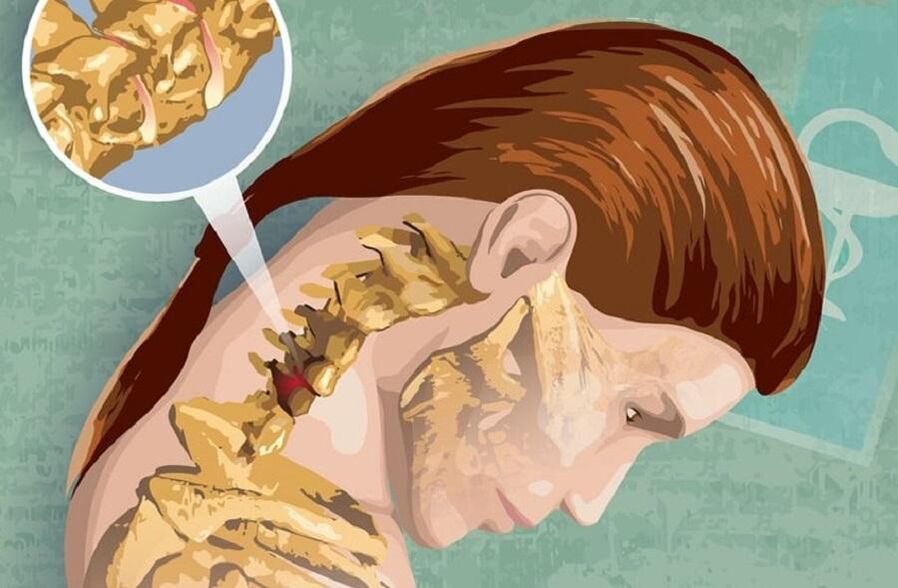In the modern world, the resonance of the disease with cervical osteochondrosis can hardly be overestimated. Osteochondrosis of the cervical region is much more common than in other vertebral regions. Almost all people over the age of twenty-five have this condition to some degree.

Cervical osteochondrosis develops mainly due to a sedentary lifestyle, which is especially facilitated by the historical transition of a person from physical labor to mental work, which, albeit moderately, is accompanied by sedentary work.
Cervical osteochondrosis is a degenerative-dystrophic disease of the cervical spine that results in damage to the intervertebral discs common to the disease of osteochondrosis in general. Since this section of the spine is naturally quite flexible, but at the same time vulnerable due to a poorly developed muscular corset, impairments of the neck or back first affect the cervical spine. Due to the fact that degenerative changes most often develop in the most mobile sections of the vertebrae, it is precisely the nerve endings at the level of C5 that suffer. . . C7 most commonly in the neck area.
Since the symptoms of cervical osteochondrosis are very controversial, they are not always considered just symptoms of this disease, which often leads to the fact that specialists of other specialties seek help. Let's take a closer look at them.
symptoms
Due to the fact that the cervical spine is quite compact compared to its other departments, even a slight tightening of the cervical muscles or displacement of the vertebrae of the cervical spine can result in compression or pinching of the nerve roots, which may also be the case in this departmentexisting ships. Well, osteophytes - bone growths, which in folk medicine are called "salt deposits", formed in the conditions of development of the disease with cervical osteochondrosis, as a result only lead to a significant deterioration in the course of the disease.
Clinical manifestations of the disease of cervical osteochondrosis, that is, its symptoms, can be divided into reflex symptoms and radicular symptoms of cervical osteochondrosis.
Reflex symptoms of cervical osteochondrosis

The reflex symptoms of cervical osteochondrosis include the so-called "lumbago", which is manifested by sharp pains in the neck and noticeably intensifies with every movement. In view of this, patients often adopt a forced head position that is as comfortable as possible. In addition, it is quite possible that a typical "crunch" occurs when turning or other head movements.
With cervical osteochondrosis, patients often experience a compressive headache that radiates to the eyeballs or temporal area of the head. Also, sometimes at the same time, the sharpness of visual perception can decrease, as if "everything is floating before the eyes. "
Vertebral artery syndrome can also develop when its nerve plexus is irritated, which is very often misdiagnosed as a violation of cerebral blood flow due to dizziness in the patient. Such a symptom of cervical osteochondrosis can be manifested by sudden movements of the head and be complicated by nausea and possible vomiting.
In addition, the reflex symptoms of cervical osteochondrosis also include a cardiological syndrome, in which there are sensations similar to an attack of angina. However, such a manifestation of symptoms of osteochondrosis is usually combined with a complex of other signs of this disease, so it usually does not cause difficulties in the correct diagnosis.
Radical symptoms of cervical osteochondrosis
Radical symptoms of cervical osteochondrosis, as a rule, appear due to compression of the spinal nerve ending - the root. Sensory disorders that affect motor skills depend entirely on which nerve root is injured, namely:
- C1 - decreased sensitivity in the occiput;
- C2 - the appearance of pain in the parietal or occipital area of the head;
- C3 - violation of sensitivity and the appearance of pain in the neck, where the root of the spine was injured, with a very possible violation of the function of speech due to the loss of sensitivity of the tongue and control over it;
- C4 - the appearance of pain and a decrease in sensitivity in the humeroscapular area of the back, as well as pain in the heart and liver area with a simultaneous decrease in muscle tone of the neck and possible respiratory disorders of respiratory function;
- C5 - decreased sensitivity and pain on the outer surface of the shoulder;
- C6 - pain radiating from the neck region to the scapula, to the outer surface of the shoulder, to the forearm and further from the wrist to the thumb;
- C7 - the same pain as in C6, but radiating from the scapula to the posterior shoulder surface, and further from the forearm to the 2nd-4th fingers, with a decrease in sensitivity in the pain area;
- C8 - decreased sensitivity and pain from the neck to the shoulder, and then from the forearm to the little finger of the hand.
treatment

Cervical osteochondrosis is a rather complex and extremely unpleasant disease, the treatment of which requires consistency, duration and stages. Therapeutic treatment of cervical osteochondrosis is primarily aimed at the complete cessation of the pain symptoms of cervical osteochondrosis and the elimination of inflammation in the neck area affected by the disease.
In the treatment of cervical osteochondrosis, patients are treated with classic analgesics such as Analgin, Ketorol or Baralgin. Although recently nonsteroidal anti-inflammatory drugs are also widely used in the treatment of osteochondrosis of the cervical spine, they effectively relieve pain and reduce inflammatory activity.
In the treatment of cervical osteochondrosis, among other things, chondroprotectors are also used, which slow down the process of destruction of cartilage tissue and, according to many experts, also contribute to their regeneration process. In addition, patients are prescribed the use of B vitamins, which improve the metabolic processes in the patient's body.
However, the use of external gels or ointments for the treatment of cervical osteochondrosis is not effective, but it makes sense, because when rubbed into the skin, an additional massage of the cervical spine is performed.
Physiotherapeutic procedures are additionally combined with traditional drug treatment of cervical osteochondrosis, and in particular, the use of magnetic therapy through special medical devices, which have gained well-deserved fame among specialists and patients, is particularly effective. In addition to the above, therapeutic massage, physiotherapy exercises and manual therapy are also used. In particularly severe cases of the disease, however, surgical intervention may also be necessary.
Prevention of cervical osteochondrosis
In itself, the prevention of cervical osteochondrosis is not difficult. Recommended:
- maintaining an active and healthy lifestyle,
- Sport, or at least morning gymnastics,
- competent organization of the workplace,
- compliance with the work and rest regime,
- if you work sitting for a long time - warm up several times during working hours and pay attention to the correct posture of your head and body during work.
It is also important to choose a comfortable pillow and mattress to sleep on. But for those who already suffer from this disease, the daily use of special orthopedic products for a comfortable sleep is highly recommended.



























